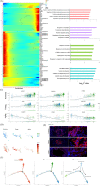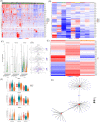Single-cell transcriptomic atlas of goat ovarian aging
- PMID: 38053167
- PMCID: PMC10699009
- DOI: 10.1186/s40104-023-00948-8
Single-cell transcriptomic atlas of goat ovarian aging
Abstract
Background: The ovaries are one of the first organs that undergo degenerative changes earlier in the aging process, and ovarian aging is shown by a decrease in the number and quality of oocytes. However, little is known about the molecular mechanisms of female age-related fertility decline in different types of ovarian cells during aging, especially in goats. Therefore, the aim of this study was to reveal the mechanisms driving ovarian aging in goats at single-cell resolution.
Results: For the first time, we surveyed the single-cell transcriptomic landscape of over 27,000 ovarian cells from newborn, young and aging goats, and identified nine ovarian cell types with distinct gene-expression signatures. Functional enrichment analysis showed that ovarian cell types were involved in their own unique biological processes, such as Wnt beta-catenin signalling was enriched in germ cells, whereas ovarian steroidogenesis was enriched in granulosa cells (GCs). Further analysis showed that ovarian aging was linked to GCs-specific changes in the antioxidant system, oxidative phosphorylation, and apoptosis. Subsequently, we identified a series of dynamic genes, such as AMH, CRABP2, THBS1 and TIMP1, which determined the fate of GCs. Additionally, FOXO1, SOX4, and HIF1A were identified as significant regulons that instructed the differentiation of GCs in a distinct manner during ovarian aging.
Conclusions: This study revealed a comprehensive aging-associated transcriptomic atlas characterizing the cell type-specific mechanisms during ovarian aging at the single-cell level and offers new diagnostic biomarkers and potential therapeutic targets for age-related goat ovarian diseases.
Keywords: Goat; Granulosa cells; Ovarian aging; Single-cell transcriptomic.
© 2023. The Author(s).
Conflict of interest statement
The authors declare that they have no competing interests.
Figures





References
Grants and funding
- 2022YFD1300202/National Key Research and Development Program of China
- cstc2021jscx-gksbX0008/Technology Innovation and Application Development Special Project of Chongqing
- 32102623/National Natural Science Foundation of China
- CSTB2022BSXM-JCX0002/PhD Train Scientific Research Project of Chongqing
- cstc2021jcyj-msxmX0875/National Natural Science Foundation of Chongqing
LinkOut - more resources
Full Text Sources
Research Materials
Miscellaneous

